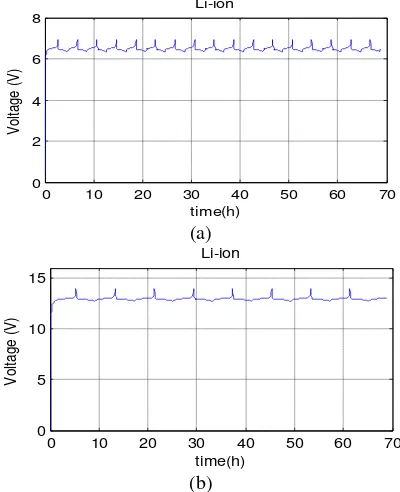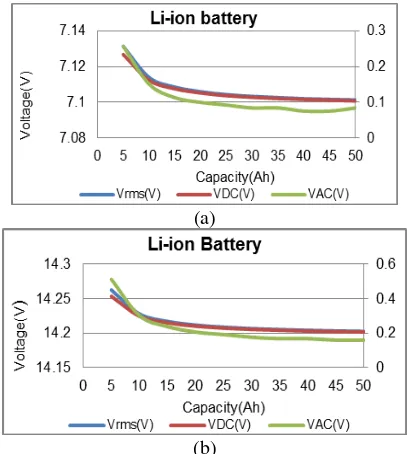ISSN:1991-8178
Australian Journal of Basic and Applied Sciences
Journal home page: www.ajbasweb.com
Corresponding Author: Rizanaliah Kasim, University Technical Malaysia Melaka (UTeM), Faculty of Electrical Engineering, Malacca, Malaysia.
Lithium-ion Battery Parameter Analysis Using Spectrogram
Rizanaliah Kasim, Abdul Rahim Abdullah, Nur Asmiza Selamat, Nur Hazilina Bahariand Mohd Zulkifli Ramli
University Technical Malaysia Melaka (UTeM), Faculty of Electrical Engineering, Malacca, Malaysia
A R T I C L E I N F O A B S T R A C T
Article history:
Received 22 February 2015 Accepted 20 March 2015 Available online 25 April 2015
Keywords:
Time-frequency Distribution, Spectrogram, Time-Frequency representation, Lithium-ion and Matlab/Simulink.
Nowadays, energy storage improves the reliability and efficiency of electric utility system. The most common device used for storing electrical energy is battery. Obtaining an accurate data of battery parameter is important because it will be avoid unexpected system interruption and prevent permanent damage to the internal structure of the batteries. The objective of this study is to apply time-frequency distribution (TFD) which is spectrogram technique in analysis of voltage charging and discharging signal for lithium-ion battery. Spectrogram represents the battery signal in time frequency representation (TFR) which is appropriate to analyze the signal before displaying the instantaneous RMS voltage (Vrms), direct current voltage (VDC) and alternating current voltage (VAC) parameter value. This paper focuses on lithium-ion (Li-ion) battery with nominal voltage of 6 and 12V and various storage capacities from 5 to 50Ah. The battery model is implemented in MATLAB/SIMULINK. From the results, the Li-ion battery parameter could be identified using spectrogram.
© 2015 AENSI Publisher All rights reserved. To Cite This Article: Rizanaliah Kasim, Abdul Rahim Abdullah, Nur Asmiza Selamat, Nur Hazilina Bahari and Mohd Zulkifli Ramli, Lithium-ion Battery Parameter Analysis Using Spectrogram. Aust. J. Basic & Appl. Sci., 9(12): 76-80, 2015
INTRODUCTION
Humanity has depended on electricity ever since it was first discovered. Without this phenomenon, more technological advancement would not have been made. When the need for mobility increased, people switched to portable energy storage device – first of all wheeled application, then portable ones and finally wearable used. The most common device used for storing energy is rechargeable battery (Erdinc, 2009).
In 1800, Alessandro Volta discovered that a continuous flow of electrical force was generated when certain fluids were used as ionic conductor to promote an electrochemical reaction between two electrodes. This led to the invention of the first voltaic cell, better known as a battery (Bergveld, 2002). In batteries, the energy of chemical compounds acts as a storage medium. A battery is a device that converts electrical energy during charging and converts chemical energy to electrical energy during discharging (Plett, 2004).
In aspect of technology, rechargeable battery is improved from lead acid battery to nickel-based battery and from nickel-based battery to Li-ion battery (Tremblay, 2007). Li-ion batteries are increasingly used in portable electronics, automotive and aerospace applications, as well as in back-up power applications due to their high power density, high energy density, no memory effect, and low
self-discharge during storage (Daowd, 2010). Accurate
estimation of battery parameter can avoid
unpredicted system interruption and prevent the batteries from permanent damage to the internal structure of the batteries. Therefore the battery information such as voltage, current and storage capacity are important for good battery performance (He, 2012).
This paper introduces the used time-frequency distribution (TFD) which is spectrogram technique to analyse and identify Li-ion battery parameter. From the TFR, parameters of the signal are estimated and then, characteristic of the signal are calculated from the signal parameters (Abdullah, 2007). This paper focused on Lithium-ion (Li-ion) battery with nominal battery of 6 and 12Vand various storage capacity from 5 to 50Ah. The battery model is implemented in MATLAB/SIMULINK. From on results, the battery parameter could be identified using spectrogram.
Lithium ion battery:
of Li-ion cells are that they have a self-discharge rate much lower than other battery, high energy density and no memory effect. In the literature, several studies have been reported regarding to Li-ion
battery (Sparacino, 2012). The equation for battery charging and discharging is used in the subsystem below;-
Fig. 1: Battery model.
Discharging
V
battE
0K
Q
it
K
Q
i
R i
.
A e
.
B it. Q
it
Q
it
(1) Charging 0
.
.
. 0,1.
B it batt
Q
Q
V
E
K
it
K
i
R i
A e
Q
it
it
Q
(2)Where Vbatt is no load voltage, E0 is battery constant voltage, K is the polarization voltage, Q is the battery capacity; it is the actual battery charge, A is the exponential zone amplitude, B is the exponential zone time constant inverse Ah-1.
Methods:
1) Time FrequencyDistribution:
Linear time frequency distribution (TFD) provide information about time variation as well as frequency spectrum of Li-ion battery simultaneously which is using spectrogram. From TFR characteristic of the signals can be calculated.The signal characteristic are instantaneous RMS voltage, direct current voltage and altrnating current voltage (Abdullah, 2013).
A. Spectrogram:
Spectrogram is one of the TFR that represents the three-dimensional of the signal with respect to time and frequency. The limitation of the FFT is that it is not able to cater non-stationary signal whose spectral characteristic changes in time. It is the result of calculating the frequency spectrum of window frames of compound signal (Zainal Abidin, 2013). Spectrogram is provided high frequency resolution and it is calculated as equation 3 below:-
2 2, j f
x
S t f x w t e dt
(3)2) Parameters Estimation:
A. Instantanenous RMS voltage (Vrms):
The instantaneous RMS current is the square root of the arithmetic mean of squares of the function of continuous waveform (Abdullah, 2013). It can define as:
max
max 2
2
( , )
f
f
rms x
V (t)
S t f df
(4)Where Sx(t,f) is the time-frequency distribution
and is the maximum frequency of interest.
B. Instantanenous Direct Current Voltage (VDC):
The direct current voltage can be calculated as;
2
2
( , )
f
f
DC x
V (t)
S t f df
(5)Where VDC is direct current voltage, is power
system frequency and Sx(t,f) is spectrogram.
C. Instantaneous Alternating Current Voltage
(VAC):
Instantaneous voltage alternating current consists of harmonic and non-harmonic distortion. The VAC can be defined as;
2 2
( )
( )
AC rms DC
V (t)
V
t
V
t
(6) Where Vrmsis instantaneous root means (RMS)voltage and VDCis direct current voltage.
Result and analysis data:
discharge voltage for Li-ion battery which used the voltage of 6V with 20Ah and 12V with 40Ah.
0 10 20 30 40 50 60 70
0 2 4 6 8 time(h) V ol ta ge ( V ) Li-ion (a)
0 10 20 30 40 50 60 70
0 5 10 15 time(h) V ol ta ge ( V ) Li-ion (b)
Fig. 2: Voltage Charging and Discharging for Li-ion battery.
Figures 3 (a) and (b) shows the time-frequency representation of the Li-ion battery signal.The hanning window is used which size window of 1024. The battery has a lower frequency of 0 Hz. The highest amplitude is represents in red color and blue color represent the lowest amplitude.
Time-Frequency Representation Fr eq ue nc y( H z) Time(h)
0 20 40 60
0 5 10
x 10-5
5 10 15 20 25 30 (a)
Time Frequency Representation
F re qu en cy (H z) Time(h)
0 20 40 60
0 5 10
x 10-5
20 40 60 80 100 120 (b)
Fig. 3: Time Frequency Representation using spectrogram.
Figure 4, 5 and 6 show the parameter signal of instantaneous Vrms, VDC and VAC are estimated from the TFR to identify the signal characteristics for Li-ion battery. It is use nominal voltage of 6 and 12V with capacity at 20 and 40 Ah. The VDC is representing the battery voltage while the VAC is used to find the capacity using equation 7. The parameters signal can be calculated using equation 4 to 6.
25 30 35 40 45
0 2 4 6 8 10 V ol ta ge (V ) time(h)
Instantaneous RMS Voltage,Vrms(t)
(a)
25 30 35 40 45
0 5 10 15 V ol ta ge (V ) time(h)
Instantaneous RMS Voltage,Vrms(t)
[image:3.595.79.279.109.355.2](b)
Fig. 4: RMS voltage (a) 6V with 20 Ah (b) 12V with 40Ah.
25 30 35 40 45
0 2 4 6 8 10 V ol ta ge (V ) time(h)
Instantaneous DC Voltage,VDC(t)
(b)
25 30 35 40 45
0 5 10 15 V ol ta ge (V ) time(h)
Instantaneous DC Voltage,VDC(t)
[image:3.595.312.515.477.720.2](b)
[image:3.595.75.294.480.724.2]25 30 35 40 45 0
0.01 0.02 0.03 0.04
V
ol
ta
ge
(V
)
time(h)
Instantaneous AC Voltage,VAC(t)
25 30 35 40 45
0 0.01 0.02 0.03 0.04
V
ol
ta
ge
(V
)
time(h)
[image:4.595.86.279.72.283.2]Instantaneous AC Voltage,VAC(t)
Fig. 6: Alternating current voltage (VAC) (a) 6V with 20Ah (b) 12V with 40Ah.
Figure 7 (a) and (b) shows the combination of Vrms, VDC and VAC of Li-ion battery signal for 6 and 12V with various capacities in the range of 5 to 50Ah. From the result, the Vrms value is appropriate to VDC and the value is
(a)
[image:4.595.312.522.106.208.2](b)
Fig. 7: Spectrogram result for Vrms, VDC and VAC for (a) 6V with 20Ah (b) 12V with 40Ah.
Figure 8 shows, result for battery capacity. From the graph, Y-axis represents the storage capacity while X-axis represent the VAC. The graph is produced using equation 7and to verify the accuracy of the equation, mean absolute error percentage (MAPE) is used. Thus, the storage capacity can be estimated.
700 exp( 23( AC)) 2.7
Q V (7)
Where Q is storage capacity and VAC is
alternating current voltage.
0 0.2 0.4 0.6 0.8
0 20 40
Battery Capacity
C
ap
ac
ity
(A
h)
Vac(V)
Fig. 8: Battery Capacity.
Conclusion:
The performance of Li-ion battery using spectrogram has been analysed and demonstrate in this paper. The observation clearly shows that the TFR can be used to estimate the useful signal parameters such as instantaneous rms voltage (Vrms), direct current voltage (VDC) and alternating current voltage (VAC) to determine the characteristic of the Li-ion battery. From the results, parameter of Li-ion battery has been determined and Li-ion battery is identified.
ACKNOWLEDGMENT
The authors would like to thank Universiti Teknikal Malaysia Melaka (UTeM) and the Ministry of Higher Education (MOHE) for providing the research grant 06-01-14-SF00119 L00025 for this research.
REFERENCES
Abdullah, A.R., A.Z. Sha'ameri, N.M. Saad,
2007. “Power quality analysis using spectrogram and gabor transformation”, In Applied Electromagnetics,
2007. APACE 2007. Asia-Pacific Conference on (pp: 1-5). IEEE.
Abdullah, A.R., N.S. Ahmad, E.F. Shair, A. Jidin, 2013. ”Open switch faults analysis in voltage
source inverter using spectrogram” In Power
Engineering and Optimization Conference (PEOCO), 2013 IEEE 7th International (pp: 438-443). IEEE.
Bergveld, H.J., W.S. Krujit, P.H.L. Notten,
2002. “Battery Management System-Design by
Modeling”, Philips Research Book Series 1, Kluwer
Academic Publisher, Boston.
Daowd, M., N. Omar, B. Verbrugge, P.V.D. Bossche, J.V. Mierlo, 2010. “Battery Models
Parameter Estimation based on Matlab/Simulink”,
The 25th World Battery, Hybrid and Fuel Cell Electric Vehicle Symposium & Exhibition.
[image:4.595.77.282.396.623.2]Electrical Power, 2009 International Conference on (pp: 383-386). IEEE.
He, H., R. Xiong, H. Guo, 2012. “Online estimation of model parameters and state-of-charge
of LiFePO 4 batteries in electric vehicles”. Applied Energy, 89(1): 413-420.
Plett, G., 2004. “Extended Kalman Filtering for Battery Management System of LiPB based HEV battery packs: Part 3. State and parameter
estimation”, J.Power Sources, 134: 277-292.
Sparacino, A.R., G.F. Reed, R.J. Kerestes, B.M. Grainger, Z.T. Smith, 2012. “Survey of battery
energy storage systems and modeling techniques” In
Power and Energy Society General Meeting, 2012 IEEE (pp: 1-8). IEEE.
Tremblay, O., L.A. Dessaint and A.I. Dekkiche, 2007. “A Generic Battery Model for the Dynamic Simulation of Hybrid Electric Vehicles”,Member IEEE.
Zainal Abidin, N.Q., A.R. Abdullah, N.H. Rahim, N. Nordin and A. Amin, 2013. “Online Surface Condition Monitoring System Using Time Frequency Analysis Technique on High Voltage
Insulators”, IEEE 7th International Power Engineering and Optimization Conference.

